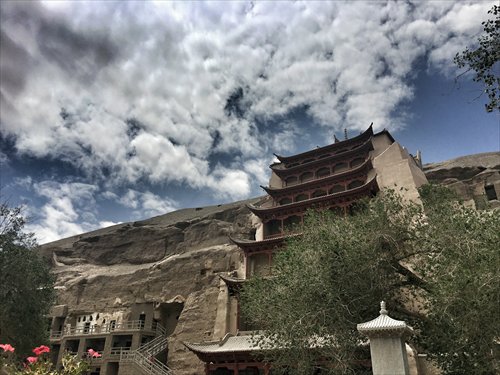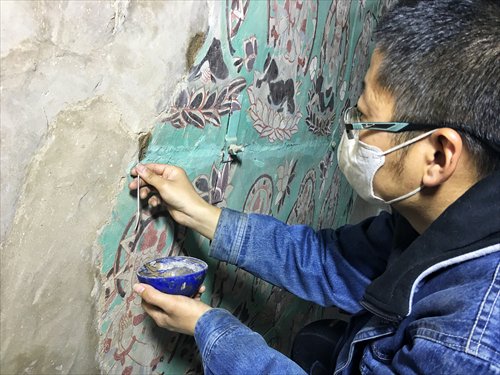A behind-the-scenes look at the efforts to preserve the 1,000-year-old Mogao Caves

A view of the Nine Story Tower at the Mogao Caves in Gansu Province Photo: Li Jingjing /GT

A restorer works on a painting in the Mogao Caves on May 31. Photo: Li Jingjing /GT
For Months, 29-year-old Yang Jinli has been focusing on repairing the mural on the wall of Cave 130, the second biggest cave among Dunhuang, Gansu Province's Mogao Caves.
Every day he stands on a nearly 20-meter high shelf, repeating the same movement over and over again from morning to night. He has to be very cautious with each move he makes, because even the least bit of excess pressure could cause the entire mural to crumble.
Repairing a mural requires only a few steps, but Yang is still working on the first step - removing the dirt from this mural. So far he has only completed a small three-square-section and still has over 1,000 square meters to go to complete this mural in this 28.2-meter-high cave.
Considering the great effort involved, repairing the paintings at the Mogao Caves, or Thousand Buddha Grottoes as they are also called, require years of dedication. Some caves have taken up to a decade to finish.
Yet a group of people from multiple disciplines, including scientists, geological engineers, chemists, artists and archaeologists, have kept at this "exhausting" job for decades, the only thing driving them being their desire to protect these priceless treasures.
Valuable heritage
A total of 735 caves were carved out from a 1,700-meter-long cliff. More than 2,000 colorful Buddhist sculptures and roughly 45,000 square meters of murals depicting Buddhist art and life in ancient China can be found in these caves.
Construction on the caves began around the year 366 and continued on for more than 1,000 years.
Dunhuang was a key hub along the Silk Road. It was along this path that Buddhism spread to China from India, and economic and cultural exchanges took place between Asia and Europe for thousands of years.
No simple task
Yang has been learning the skills needed to repair these murals since he was 19. He spent his first three to four years observing his teacher before he had a chance to work on the murals himself. Interestingly enough, he originally didn't come from a history background but a technical one.
"At first it was just a way to earn a living," Yang told the Global Times.
Many of those in this field had similar beginnings.
"The longer I spent time with them and got to know them, the more responsibility and sense of achievement I felt," Yang said.
"We realized that restoration of murals is a very specialized technique very early on," Dr. Su Bomin, the director of the Dunhuang Academy's Conservation Institute, told the Global Times.
He explained that during repairs, craftsmen have to take into consideration the artistic style of the mural so as to make sure repairs don't alter it.
"You can't treat restoring relics as a simple skill, using some tool to play with dirt and materials," Su said.
"Even the skill to paste a mural back together takes long training."
Making things more difficult is that restoration is not taught in schools in China.
Wang Xudong, the director of the Dunhuang Academy, emphasized the need for nationwide training, as he pointed out that all the craftsman working in the caves had been trained by Dunhuang Academy over the years.
Painstaking care
"Restoration of cultural relics is a unique science and technology, not a simple craftsman's job," Su told the Global Times.
Before craftsmen start to repair a mural, it is crucial that field research, analysis and tests be carried out by scientists. Only through the proper research can the best way to prevent deterioration and repair a relic be found. Once a plan has been written up, craftsman can then start their restoration project.
Due to lack of oversight over hundreds of years, Mogao suffered sever damage from water and sand entering the caves, sculptures falling down and murals flaking off the walls. It wasn't until the Dunhuang Cultural Relic Research Institute (now the Dunhuang Academy) was established in 1944 that things began to change.
Another factor that has led to the deterioration is the fact that the murals were painted on conglomerate rock, which is easily damaged by rain and weathering.
As more attention and investment has been put into preserving Mogao over the years, more advanced technology and techniques have been introduced through international cooperation.
In 1997, the Dunhuang Academy and the Getty Conservation Institute in the US began an eight-year project to identify and implement proper preservation strategies in Cave 85, which possesses a large amount of paintings.
Due to salt deterioration, flaking and loss of adhesion between the conglomerate rocks and earthen plaster, a number of murals in Cave 85 had detached from the walls and were susceptible to collapse. Substantial soluble salt contained in the rocks in the cave also contributed to the deterioration as well.
Through their collaboration, they develop a way to remove the salt from the dirt and rocks.
Although restoration work on Cave 85 was finished more than a decade ago, the cave is still not open to the public so the team may observe the effectiveness of their repair methods and observe any possible changes.
"Loss of these relics is irreversible, so we can't fail," Su said.
(History Reincarnate: Part 2, which will focus on the digital preservation of the Mogao Caves and international cooperation, will be published next week.)
Newspaper headline: History reincarnate